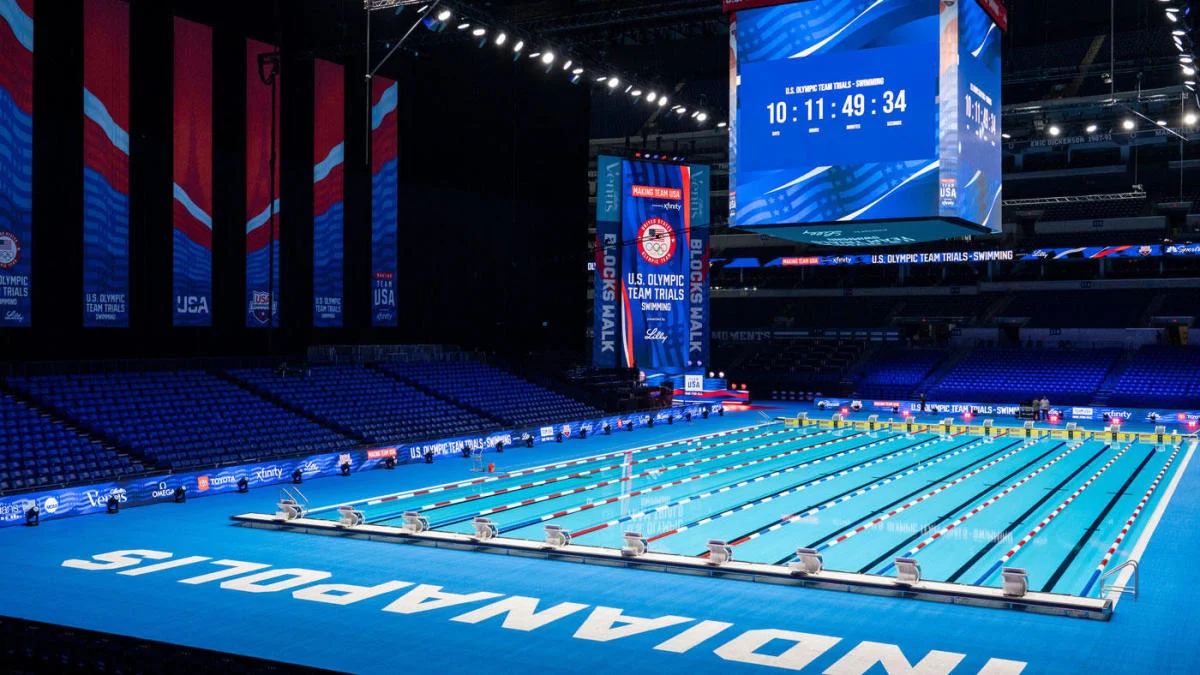By: Felix Xie
Over the course of this week, we will see the world’s largest indoor swimming pool in action: the Lucas Oil Stadium in Indianapolis, Indiana, where the Olympic Trials will be held.
By Felix Xie
When Shana Ferguson, USA Swimming’s chief commercial officer, saw firsthand what the location of the Olympic Trials in Omaha, Nebraska looked like in 2021, she wondered what the Olympic Trials would look like in a football stadium.
Now, after three years of hard work designing, contracting, and coordinating, their hard work has finally come to fruition. Ferguson and her team of sponsors are days away from officially starting the Trials. Located in the Lucas Oil Stadium, 2024’s Trials will be the first ever Olympic Trials to be held in a stadium.
The Trials are set to start on June 15th and will run until June 23rd. During the meet, which will occur over Father’s Day and Juneteenth, the organizers expect to see more than 30,000 people, destroying the previous world record. With these expectations, it is no wonder why the USA Team wanted a larger venue.
“This is the first time this has ever been attempted in the world,” said Mark Dodd, president of Dodd Technologies, USA Swimming’s general contractor for the Trials. They were tasked with building the pool’s deck, scoreboard, signs, and other miscellaneous items of the meet.
Myrtha Pools, a company that focuses on the construction and deconstruction of temporary pools, built the three pools in the stadium. Spear Corp., located in Roachdale, Indiana, built all plumbing related items.
The stadium will consist of three pools: one competition pool, which will be 50 meters long and 3 meters deep, and two general warm up pools. These three pools will be separated by a curtain that will begin at the 50-meter mark of the competition pool. USA Swimming built the pool because “[w]e need to make sure to give these athletes an amazing experience that will be, for many of them, the pinnacle of their careers. We have a responsibility to make this a really wickedly cool environment for them,” said Ferguson.
To build the pool, the contractors moved nearly two million gallons of water to the site, which will be held in tanks where it will be chlorinated and circulated in the pool. “When you watch this on television, it will look like an in-ground pool, like the pool is on floor level,” Ferguson said. “But we’re putting an above-ground pool on the cement and building a deck around it. The pool with the decking will actually end up striking the first 10 rows of seats.”
Another reason USA Swimming wanted a larger pool was the rising demand for competitions and the inadequate venues to hold the people. Indianapolis also held the competitions in 2000 at the Indiana University Natatorium. The venue for the next cycle, held in Long Beach, California, in 2004, also proved inadequate. In 2016, nearly 20,000 fans went to watch the Trials in 15 sold-out sessions. Unfortunately, the venue could only hold 13,000 people. This is why USA Swimming chose the Lucas Oil Stadium as its venue.
“The thing I’m most looking forward to is actually having space. In Omaha, it got so crowded that I just stopped going into the main pool and watching the races because I couldn’t get over there quickly enough to help people warm up and warm down. So, I would just watch it on the big screen in the warmup pool,” said Bob Bowman, who famously coached Michael Phelps.
During this Trials we will finally get to see what the pool looks like and how it will revolutionize how venues hold swim fans.











